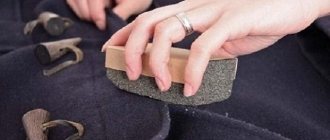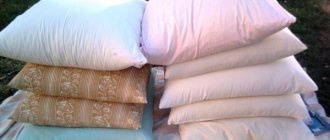Products made from natural wool take pride of place in any person’s wardrobe. Soft and surprisingly warm pants and skirts, jackets and sweaters do not wrinkle, get dirty little and, with proper care, can “reliably” last for more than ten years. Therefore, it becomes very annoying when a new woolen item sharply decreases in size after washing. You can restore a deformed product using ammonia, hair conditioner, hydrogen peroxide, or by mechanical stretching.
How to restore wool?
In cases where the shrunken wool is not very deformed, you can use this method of restoring it:
- Mix water and ammonia in equal proportions.
- Soak the item in the resulting solution for 120 minutes.
- Afterwards, rinse well, using a special wool conditioner.
1 Jul.
2022 Interesting materials:
How to turn off Google Assistant on Xiaomi? How to mute the microphone using the keyboard? How to turn off night mode on Android? How to turn off a PC with a command? How to turn off a PC using a timer? How to turn off advertising? How to turn off airplane mode on Samsung? How to turn off dark theme on iPhone? How to turn off Windows 10 keys? How to feed a two-week-old rabbit?
Causes of deformation of woolen products
After improper washing, the size of your favorite item may decrease by 2-3 orders of magnitude.
Wool fibers are of natural origin. Consisting of many cells, on the outside they are covered with tiny scales. The fibers themselves are quite wide and are in close contact with each other, so woolen clothes are warm. If the jumper is simply immersed in hot water, then nothing special will happen to the wool. However, when the fibers begin to rub against each other, as happens during machine washing, the scales “fluff” and are firmly connected to each other. As a result, the space between the fibers decreases, which leads to deformation of the product. Often the size of your favorite item can decrease by 2-3 orders of magnitude.
Manufacturers of modern washing machines have successfully solved this problem by providing a special mode for washing wool products, when the drum does not rotate, but only slightly rocks the clothes, preventing the fibers from sticking together.
There are several reasons for the deformation of wool fabric:
- water temperature is too high;
- incorrect selection of detergent;
- The mode set in the washing machine is not suitable for processing woolen items.
It is not always possible to completely restore the original appearance and size of a shrunken product. The success of the operation depends on the composition of the material, since it is much easier to restore wool with the addition of synthetics than a pure wool item. Equally important is the length of time the clothes remain in the rotating drum and the temperature of the water.
General rules
Wool does not like frequent washing: once every six months is enough. In order not to subject the item to frequent water procedures, it is worth ventilating it well from time to time.
If the fabric is prone to shedding, then to fix the color you need to add a little vinegar. The acidic environment does not allow the paint to wash out.
It is very important to choose the right temperature when cleaning woolen items. This fabric does not like sudden changes, so both too cold and very hot water are catastrophic for it. The optimal temperature is 30°C.
Soaking has an extremely negative effect on wool; it is better not to resort to it. The less the item is in the water, the better, so the entire wash should take no more than 45 minutes.
Rinse
This is a very important procedure for caring for wool products. If rinsing occurs in a machine, then any suitable conditioner must be added to a special tank. It will soften the water, protect the item from wrinkles, and also give the item a light, pleasant smell.
To rinse with your hands, you can also use wool conditioner, or you can remember your grandmother’s trick and dilute glycerin in a basin at the rate of half a tablespoon per 5 liters of water. Rinsing in such a solution protects things no worse than store-bought detergent.
A wool jacket that has shrunk - let's stretch it on the carpet
To reliably and safely stretch the jacket without losing its shape, we will use the “grandmother’s” method. It will require a solution of the following ingredients:
- 5 liters of cold water;
- 5 tablespoons of ammonia;
- 1 tablespoon of turpentine;
- 1 tablespoon cologne.
Operating procedure:
- Soak the affected product for an hour and a half in the solution.
- Rinse in clean water at the same temperature and squeeze a little.
- Baste the jacket to a piece of thick fabric. To do this, spread a cloth on the table - a tablecloth, a sheet folded in 4 layers, a terry towel. Lay the jacket on top of the fabric, stretch it with your hands and begin sewing it along the contour to the fabric below. Make stitches in 2 cm increments. While sewing, constantly adjust the position of the jacket.
- Stretch the fabric to which the jacket is sewn onto the frame (as indicated in the original recipe). In modern realities, you can do it simpler: lay out the fabric with the jacket on a cleaned rug and attach it to it with pins, pulling it tightly. To do this, you will need a helper to hold the fabric taut while you pin it to the carpet.
- Dry your jacket this way.
Precautionary measures:
- this method is absolutely not suitable if there are small children or playful animals in the house;
- count and write down the number of pins used: you should collect the same number later.
Why do things sit down and fall off?
Fabric, woven or knitted, consists of threads formed by fibers of raw materials - wool, cotton, flax. These threads have different degrees of twist, and the fibers have different lengths. The more tightly the thread is twisted and the shorter the fibers that make it up, the better the shape of the knitted item is preserved. Conversely, the weaker the twist and the longer the wool fibers, the more shrinkage options are possible. Items made from roving (straight, untwisted wool tape/thread) or long-staple merino yarn shrink the most.
Things shrink and fall off when they are subjected to critical impacts on the threads from which they are knitted, usually due to improper washing. High temperature, alkali plus mechanical action is just what is needed to felt wool. It is this combination of factors that underlies the handmade felting technique; felt is made in the same way. By washing a woolen sweater in a hot, concentrated solution of active detergent, and even using friction (by hand or in a washing machine on gentle programs), you recreate the ideal conditions for the felting process. The fibers of the threads become tangled and firmly adhere to each other - as a result, the fabric becomes uniform and dense. But even during washing without friction (and matting), a woolen item can shrink when the temperature changes, so you need to rinse it in the same warm water as you wash it. Do not forget that when rinsing in an automatic machine, cold water is always used.
The tighter the knitting, the less likely it is that the fabric will shrink. If the item is openwork or loosely knitted, wash it very carefully, since the chance of shrinkage is quite high, the item can decrease by 30% or by half.
We remove the pellets with a pumice stone, a comb or even Velcro
Often the age of a sweater is revealed by numerous pills. But this does not mean that it should be thrown away. By the way, the most common pumice will help get rid of the problem. If you carefully run it over the surface of the clothing, then there will be no trace of the pellets left. The same can be done with a comb and tape.
The simplest way to lose weight is called healthy sleep
Aries and Sagittarius: the most similar zodiac signs
The Lord of the Rings universe made from LEGO parts is included in the Guinness Book of Records
Drying Features
Follow a few simple rules:
- Do not twist the product. Just squeeze them lightly with your hands.
- To get rid of excess water, use a terry towel.
- Dry items in a horizontal position. Lay them out on a flat surface with a cloth underneath and let them dry naturally.
- Do not hang sweaters or cardigans on a line, as they will stretch under their own weight.
- Do not dry things near a heat source, on a radiator or heater.
What to do if the item consists of different fabrics
To avoid having to deal with problems with items becoming deformed after washing, you must follow the basic washing rules. To know them, you need to leave a label on your clothing with the manufacturer’s recommendations. It contains useful information on what water temperature the product can be washed at, whether it is allowed to use an automatic machine or whether the item can only be washed by hand, whether it is permissible to wring it out and use bleaches and stain removers.
To prevent tissue shrinkage, experts recommend:
- pay attention to the manufacturer’s recommendations on the label of shrunken clothing;
- wash at a temperature of no more than 30 degrees;
- Buy wool products one size larger, since after the first wash they will shrink anyway.
Most often, linen, cotton, silk, wool and some synthetic materials shrink when washed. To avoid fabric shrinkage, you need to know how to care for it. If it was not possible to prevent deformation, then you will need to choose the correct restoration method.
Cotton
You can restore the shape of cotton clothes using a regular vinegar solution:
- Dilute 3 tablespoons of vinegar per 10 liters of water.
- The product is dipped into the prepared solution for 10 minutes.
- Next, they are machine washed on a delicate cycle and hung to dry on hangers.
Cotton clothing needs proper care:
- it cannot be washed at water temperatures above 60 degrees;
- stains are eliminated before loading into the machine;
- new cotton items are washed in cold water and dried naturally;
- Thin fabrics are washed in a machine in the delicate or hand wash mode.
Shrunken linen products are restored:
- rinsing in cool water;
- drying in fresh air without pre-squeezing;
- ironing with slightly stretching movements.
Recommendations for washing linen:
- clothes are washed only on a delicate cycle or by hand;
- the water temperature should not exceed 40 degrees;
- It is not recommended to squeeze things out with your hands.
Wool
The easiest way to return shrunken woolen clothes to their original shape is to use conditioners:
- Dilute several caps of a properly selected product in a bowl of warm water.
- Soak the item for 15 minutes.
- Remove from the water and hang until it drains completely.
- Place on a terry towel until completely dry.
- Place on a dry towel and pin to it with pins or snaps for stretching.
To prevent woolen items from becoming deformed during the washing process, you need to:
- wash things at a temperature not exceeding 30 degrees;
- use gentle detergents without aggressive substances;
- do not machine wash;
- use special household chemicals for woolen clothes;
- Take woolen coats to the dry cleaner.
Silk and synthetics
To prevent silk and synthetic items from shrinking during the washing process, you should:
- do not use aggressive detergents;
- wash in lukewarm water;
- do not use rough mechanical force;
- hand wash only;
- rinse at least 2 times in cool water with the addition of a suitable fabric softener.
If a shrunken shirt or dress is made from different fabrics, you can stretch them as follows:
- Soak the product in cool water for 15 minutes and then put it in the machine. Wash without powder on delicate cycle. The fibers of the fabric should stretch a little. Then you need to take the item out of the machine and hang it up to dry. Wet things are shaped by hand. Clothes should dry in the fresh air or in a well-ventilated area.
- You can dilute 3 tablespoons of 3 percent hydrogen peroxide in 10 liters of water and soak the clothes for one hour. Next, the laundry is taken out of the basin and dried in the fresh air.
Of course, you can say that having the necessary knowledge, you are not at all afraid of any shrinkage. But why waste your time and energy trying to deal with shriveled things if you can prevent this from happening in the first place?
We invite you to familiarize yourself with Begonia Elatior care after purchase and in winter at home
Experts advise:
- Always pay attention to the tags on clothes before washing them. By adhering to the recommendations described, you will not be able to fit into your favorite dress;
- try to wash at a temperature of about 30 degrees - no higher. Take care of your things and they will last long in return;
- It is better to buy woolen clothes a size larger, since after the first wash they will shrink in any case.
You shouldn’t go to extreme measures and then frantically look for a way out of the situation - it’s much easier to take care of your things right away. But if an unpleasant situation happens to you when the fabric shrinks after washing, don’t despair - now you know exactly what to do!
Ironing
Typically, wool items are not prone to wrinkles, so they do not need to be ironed. But if such a need arises, then you need to iron the fabric from the wrong side only after it has completely dried. When ironing, be sure to use a damp cloth and check the information label again. If the iron does not have a “wool” setting, the temperature of the iron should be low.
By the way, ironing can help if the item, despite following all the rules, still shrinks. To do this, the wool needs to be slightly wetted and ironed through a damp cloth, stretching the fibers to the desired size. Using this method, be sure to dry the item with an iron until there is no moisture, otherwise all your efforts will go down the drain.
Clothes made from wool never go out of fashion and serve their owners for a long time. Yes, woolen items require special care, but for those who know and follow the simple rules, this matter does not seem so difficult.
Tricky Tips
In addition to all the basic recommendations, experienced housewives usually use a number of useful tips that allow them to preserve the original beautiful appearance of woolen products for a long time.
- Stains from juice or berries are much easier to remove if you briefly sprinkle them with salt first.
- lipstick off clothes with rubbing alcohol.
- To reduce the likelihood of colored items shedding and soften the water a little, you can add two teaspoons of vinegar essence.
- Adding a couple of drops of ammonia will help significantly soften the fabric .
- To effectively remove contaminants, it is not necessary to use household chemicals. Folk remedies can also cope with this - mustard powder, potato or bean broth. You can use lemon powder for whitening
- If, despite following all the recommendations, your clothes still shrink, you should not be upset or re-wash your favorite sweater. You can sprinkle it with a little water and iron it, gently stretching the fabric.
- Woolen clothes should be stored in small piles in the closet; larger and heavier items of clothing should be placed downwards.
- If you place a few paper napkins soaked in lavender oil in your closet, your clothes will always smell nice. This measure also reliably protects against moths.
All of these tips help you successfully wash woolen products and avoid possible unpleasant consequences. If there are some concerns, you can always entrust the cleaning of a delicate item to professionals.
What can you do with shrunk socks and mittens?
Such a misfortune is doubly unpleasant if it happens in severe winter, and socks or mittens that have become smaller after washing are the only ones. To help the grief, you will need:
- vinegar;
- spray;
- many newspapers;
- any strong clips or clothespins.
Instructions:
- Soak things in water (you can add hair balm).
- Stretch them a little with your hands.
- Remove and squeeze without twisting.
- Spray wet items with vinegar from a spray bottle.
- Place more crumpled newspapers inside and secure the edges of the cuffs with clothespins to prevent the newspapers from falling out. You will have to change the paper sometimes, and the more often you can do this, the faster everything will dry. The smell of vinegar disappears quite quickly.
Woolen items are useful to wear for people suffering from rheumatism, osteochondrosis, orthopedic diseases and circulatory disorders.
Vinegar and crumpled newspapers will help restore the shape and size of mittens or socks made of wool.
The freezer is a sweater's best friend.
If your sweater is leaking lint, you can carefully roll it up, put it in a ziplock bag, and pop it in the freezer for a couple of hours. After this time, the sweater can be put on immediately. This method is best suited for angora products. The fibers will be better held in the yarn. If you notice moths in your closet, again throw the item in the freezer. Low temperatures will kill moth eggs.
Each of these methods will help you!
Found a violation? Report content
Wardrobe items
Any wardrobe items can sit down after washing: dresses, shirts, trousers, T-shirts, T-shirts and even your favorite sneakers. The way out of the situation depends on the materials from which the clothes are made.
Not only woolen coats can fit, but also those made from any natural or synthetic fibers. You can return to the original form as follows:
- Rinse the coat in cool water and squeeze lightly with your hands.
- Prepare a flat surface (preferably a table) covered with a terry towel or sheet.
- Place a damp coat on top and cover it with a second towel.
- As soon as the product begins to dry, you will need to periodically stretch its edges.
You can also stretch the coat using an iron:
- A cotton cloth is placed on the wet coat and the product is ironed.
- During ironing, its edges are pulled to the sides.
- To soften the fibers and improve stretching, it is recommended to use steaming.
To return the dress to its original shape, it must be revived with cold water and an iron. First, soak it in cold water for a quarter of an hour, then wait until the water stops flowing and place it on a table or clean floor. After drying, iron the dress with a hot iron through gauze or thin fabric, while simultaneously pulling out its edges with your hands.
A universal method for stretching a T-shirt or tank top that has shrunk after washing, regardless of the fabric:
- The T-shirt is soaked for 10 minutes in water no hotter than 40 degrees, lightly wrung out and shaken.
- If there are stickers, inscriptions and pictures on the T-shirt, then you should handle it carefully so that the design is not damaged or faded.
- A damp T-shirt is laid out on an ironing board, gauze folded in several layers is placed on top, and the clothes are steamed with an iron from a distance of 10-15 centimeters. In this case, the T-shirt should be pulled with your hands in different directions.
- Places with inscriptions and stickers should not be steamed, let alone stretched.
- While steaming a T-shirt, do not dry it completely. It is better to hang it in the fresh air with the neck down. In this case, you will need to once again carefully pull the material with your hands in the right directions.
To stretch a T-shirt one size, you need to:
- Soak it in cold water with a little shampoo.
- Squeeze lightly with your hands and place on an ironing board.
- Stretch and secure with pins.
- Wait until it dries like this.
Recommendations:
- Soak the shirt in cold water for half an hour. Remove it from the water and lay it out on a towel without wrung out. So it should dry by periodically changing the towel to a dry one. In this case, the shirt must be stretched in different directions with your hands from time to time. This is a universal method suitable for all types of fabrics.
- Cotton shirts are stretched by soaking in cool water for 10 minutes and placing on the body or mannequin until completely dry. This will allow the shirt to fully stretch to fit your body and regain its lost shape.
- White shirts are soaked in milk for half an hour, then rinsed in cool water and laid out to dry horizontally on a terry sheet or towel.
Methods for restoring clothing directly depend on the type of fabric:
- You can return a cotton blouse to its original shape using vinegar. To do this, add 45 ml of 3% vinegar to 10 liters of water, and the product is lowered into a basin with the mixture for 10 minutes. After this, the blouse is machine washed on a delicate cycle. Next, it is hung in the fresh air and, during the drying process, it is periodically stretched with its hands in different directions;
- a denim blouse is restored by ironing and steaming;
- viscose is soaked in cold water for several minutes and hung over the bath until the moisture is completely drained. After this, the blouse is dried in a horizontal position in a well-ventilated area. From time to time it is necessary to stretch it with your hands in different directions.
Pants sat down, pants
We stretch pants or trousers that have shrunk after washing:
- the trousers are briefly immersed in warm water, hung over the bathtub and stretched on a horizontal surface until they dry completely naturally;
- in the warm season, the trousers can be wetted and put on the body by pulling the trouser legs from the bottom with attached weights. So you will need to wait until the trousers are completely dry.











